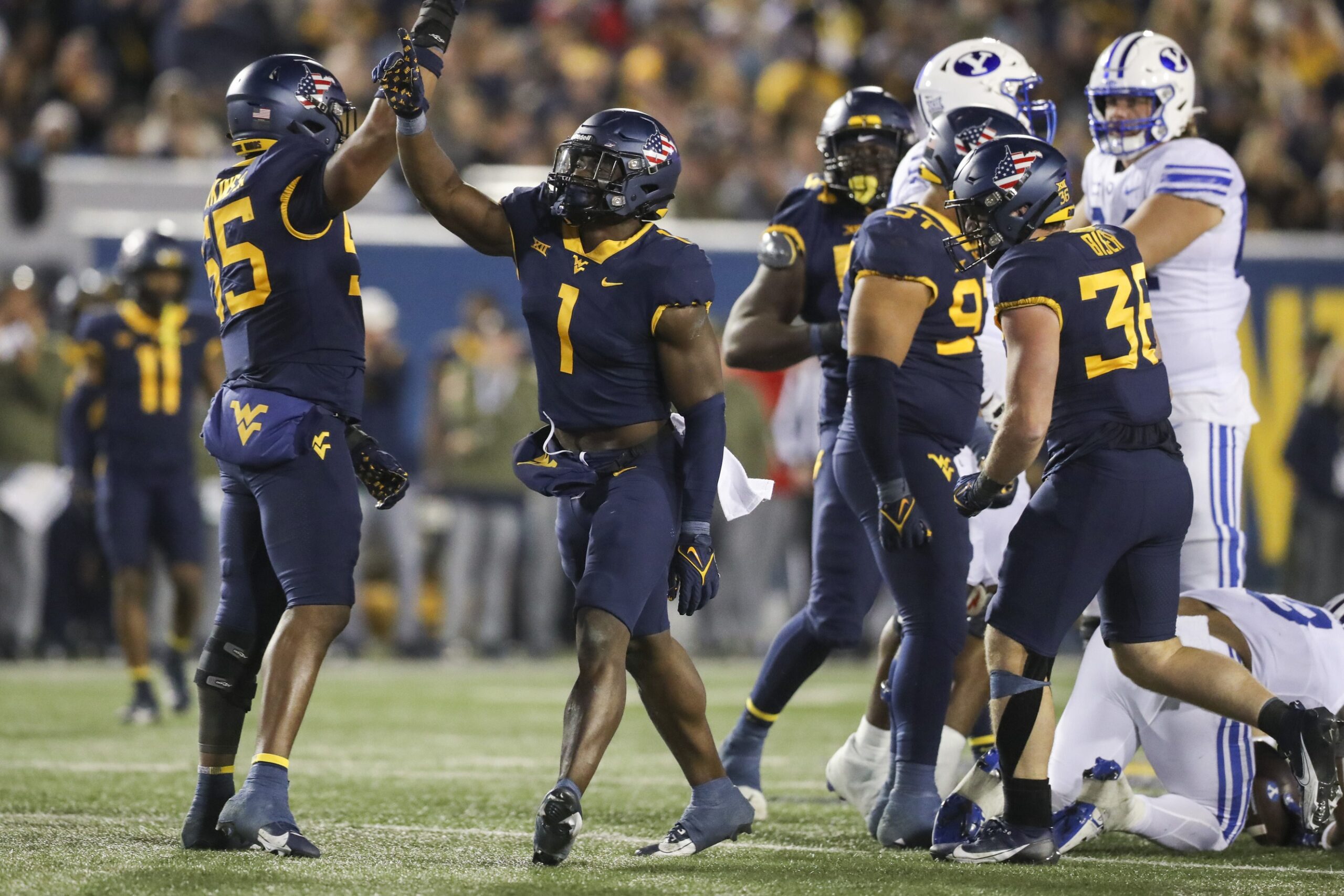The day after a win feels infinitely better than the day after a loss. Fans everywhere understand that feeling as universal. After a rough start to the Head Coach Neal Brown era, West Virginia Mountaineer fans may understand this better than most. Without saying it directly, our preview of West Virginia’s Saturday night matchup against BYU should have signaled that we believed the Mountaineers would cruise over the Cougars. Now, the morning after, we look at what went right and what went wrong after WVU wallops BYU by a final score of 37-7.
The Day After: WVU Wallops BYU
November nights in Morgantown have featured some wild surprises over the year. No doubt, it features one of the toughest environments outside of the SEC and the top Big Ten venues for opposing teams to visit. Great football has been played under those conditions. BYU could not possibly prepare fully for that road trip, their furthest trip East against a Power Five team in years. The Cougars did not match up well against the Mountaineers on paper either. WVU features a ground-and-pound offensive identity that has been moving the ball well over their last three games particularly. The Cougars have not defended the run well. Opposing units find some success running against West Virginia, but BYU runs the ball poorly. In short, BYU faced long odds rolling into Morgantown this weekend.
That said, Mountaineer fans know all too well to expect the unexpected. They have complained–rightfully so–that Brown has not marched out a team that truly felt like the blue-collar football program West Virginia has built over the years. The killer instinct simply seemed lacking. As a result, it has too often been one thing to say West Virginia should win a game. Too often, it has been another entirely for them to control the outcome the way they should.
Today, though, we can write a headline like, “WVU wallops BYU” with no reservation. Sure, the win offers West Virginia little gained in terms of strength of schedule. They did not demolish a ranked team. However, what they did, was confidently and competently dismantle an opponent that they absolutely should have beaten. Fans should draw some comfort in that.
Mountaineers Run Rampant
Let’s talk about a few things that jump off the page. The 30-point margin represents the largest margin of victory in Big 12 conference play since 2018. The closest margin of victory under Brown came in 2020 when West Virginia beat Kansas State by 27. The Mountaineers rushed for 336 yards. That is, well, a lot. They have not run for 336 yards against an opponent since November 2016, when they piled up 388 rushing yards against Oklahoma. The Sooners, of course, won that game 56-28.
Two backs carried most of the load. Jahiem White simply looked electric, as he paced the team with 146 yards to average over nine yards per carry. CJ Donaldson, who has been improving every game, added 102 yards on 14 carries and averaged over seven yards a carry himself. Donaldson added two scores on the ground in the first half. Donaldson and White truly played the thunder and lightning roles, as Donaldson set the tone early. After Donaldson left the game (temporarily) with an apparent foot or ankle injury, White then played lateral football accelerating through big holes for some serious gains.
The Mountaineers did not even need much production from their quarterbacks Garrett Greene and Nicco Marchiol. Between the two, they carried the ball just 7 times for 59 yards. Given the ankle injuries Greene has dealt with this season, Brown and Offensive Coordinator Chad Scott surely welcome the reprieve. The production from the two backs though also says this about the game: West Virginia imposed its will in exactly the way it envisioned coming into the game. They controlled the clock, too, possession of the ball for 35 minutes.
Defense Stifled the Cougars
For as confidently as the offense played, the defense might have been better. We say might only because we recognize that the Cougars marched out an inexperienced junior college transfer playing his first snaps of Power Five football. They also surrendered some yards, 210 to be exact, to Jake Retzlaff. There were periods in the first half where our notes careened into “not this again,” reflecting on how often Mountaineer defenses have made backup quarterbacks look like Heisman candidates.
The passes Retzlaff completed, however, came on quick releases to soft spots in the zone. They read their scouting reports. They knew where the openings would be. More importantly, West Virginia stepped up when they needed to. They gave up some yards in holes in the field. But when the field shrank, the defense turned up the heat and kept Retzlaff off balance. BYU converted just 27% of its third down attempts. They also went zero for three on fourth-down conversions, showing just how readily the Mountaineers imposed their will on defense, too. The three sacks and half-a-dozen more tackles for loss certainly helped that cause.
Beanie Bishop, by the way, deserves his paragraph. He plays physically and has earned his growing reputation as a shut-down cornerback. Brown told fans and media in his pre-season remarks that Bishop was a player to watch. He told us that if Bishop kept focused on his game, he would play himself into an NFL roster spot. That remains to be seen given the NFL draft’s unpredictability in the later rounds. We can say with confidence, however, that Bishop has acquitted himself as well as anyone on the roster this season.
Add those things up, and the Mountaineers pitched a shutout for over 53 minutes, yielding a lone score in the final quarter while BYU trotted out its starters against WVU’s backups. The snaps yielded some needed experience for some players we have not heard much from this season. The fact speaks loudly, however, as to just how dominant the team was last night.
What Comes Next?
Most immediately, we imagine that what comes after reading a headline like “WVU wallops BYU” is a surgical focus during practice on discipline. The Mountaineers, as dominant as they were, struggled in a couple of areas: special teams and penalties.
The latter might be errant in some ways. The Cougars and Mountaineers, to date, play two of the most disciplined brands of football in 2023. Neither team has been penalized very often. Imagine our surprise, then, when the telecast offered this: through three quarters the teams saw the most combined penalties in an FBS game this season. The Cougars saw the worst of it, as they were called for 100 yards of penalties. The Mountaineers, however, added 10 penalties for 71 yards to the mix, and they got away with a few in the first half. West Virginia certainly needs to clean that up traveling to Norman next week.
West Virginia also played poorly overall on special teams. Michael Hayes offered the lone exception, at least on the field goal unit, where he finished a perfect three-for-three with a long field goal of 46 yards. The Mountaineers, could not seem to get the ball out of their end zone in the second half. Indeed, the half started with a kickoff return for a touchdown that was called back on a questionable holding penalty. On the next drive, the Cougars almost returned another one. They need to fix that, too.
Beyond the immediate comes a road trip to face Oklahoma. The Sooners lost two straight, against Kansas and Oklahoma State. They will certainly be looking to reserve course and keep their hopes for a spot in the Big 12 Championship game alive. After that, West Virginia finishes with a home game against Cincinnati and a road trip to Waco to face Baylor, both of which should be easy wins.







